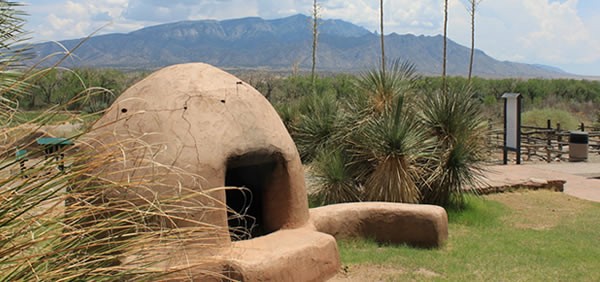Coronado Historic Site
Introduction
Text-to-speech Audio
In 1540, Francisco Vásquez de Coronado—with 500 soldiers and 2,000 Indian allies from New Spain—entered the Rio Grande valley somewhere near this site. Coronado was searching for the fabled Seven Cities of Gold. Instead of treasure, he found a dozen villages inhabited by prosperous native farmers. These newly "discovered" people spoke Tiwa, and their ancestors had already been living in this area for thousands of years. Coronado called them: Los Indios de los Pueblos or Pueblo Indians. He and his men visited all twelve Tiwa villages during the course of the next two years because they survived on food and other supplies that they obtained from them. Without the assistance of the Tiwas (willing or unwilling), Coronado and his men very likely would have starved to death.
Kuaua was the northernmost of the twelve villages. Its name means "evergreen" in Tiwa. It was first settled around AD 1325 and was occupied by approximately 1,200 people when Coronado arrived. Conflict with Coronado and later Spanish explorers led to the abandonment of this site within a century of first contact. Today, the descendants of the people of Kuaua live in the surviving Tiwa-speaking villages of Taos, Picuris, Sandia, and Isleta.
When archaeologists from the Museum of New Mexico excavated the ruins of Kuaua Pueblo during the 1930s, they discovered a square kiva in the south plaza of the community. This kiva, or ceremonial chamber, contained many layers of mural paintings. These murals represent some of the finest examples of Pre-Columbian art ever found in the Untied States. Painstaking efforts allowed for the recovery of the murals, and fourteen examples of the orginal art are on display in the Visitor's Center. The painted kiva was reconstructed and one of the mural layers was also recreated. The Visitor's Center was designed by noted architect John Gaw Meem. It contains prehistoric and historic Puebloan and Spanish Colonial artifacts on exhibit with several hands-on components.
Images

Backstory and Context
Text-to-speech Audio
Coronado Historic Site offers ramada-covered picnic tables with magnificent views of the Rio Grande and Sandia Mountains. Enjoy the history and beauty of northern New Mexico along with the many other attractions as you travel along El Camino Real National Historic Trail and/or Jemez Mountain Trail National Scenic Byways.
